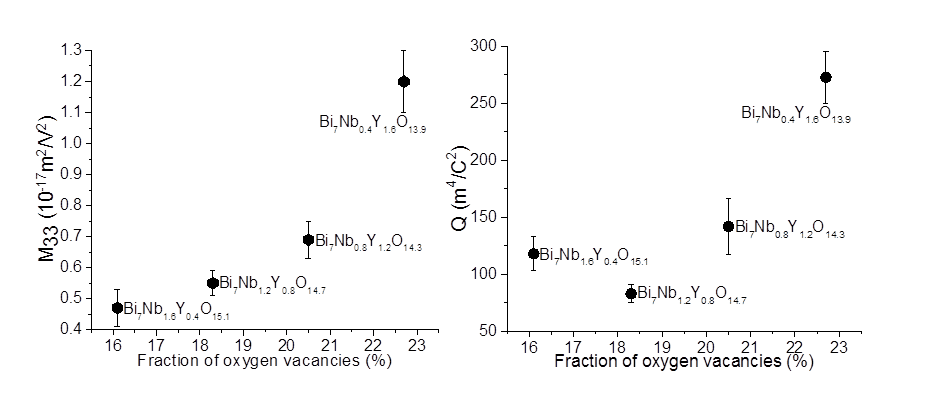
LARGE NON-CLASSICAL ELECTROSTRICTION IN δ-PHASE Bi2O3
2School of Chemistry, University of Birmingham, Edgbaston
3Department of Materials, Nuclear Research Center-Negev, Beer-Sheva
4Chemical Research Support, Weizmann Institute of Science, Rehovot
Electrostriction is the induction of strain in a material by an applied electric field. Electrostriction is characterized by Mikjl (m2/V2) and Qikjl (m4/C2). M correlates the induced strain to the electric field squared, and Q correlates the strain to the polarization induced in the material. M and Q are linked by the material’s dielectric constant, ε, – Q=M/[ε0(ε-1)]2. Commercial electrostrictors, such as PMN-PT, with M=10-16-10-15 m2/V2 possess high dielectric constants (ε=10,000-20,000) and therefore exhibit low Q (QPMN-PT<0.1)1. Ceramics with ε<100 usually ehxibit M values in the 10-21-10-22 m2/V2 range and relatively high Q. The highest Q reported, before 2012, is for MgO doped Alumina- QAlumina=1.581.
In light of these data, our recent report2 that thin films of Gd+3 doped CeO2 (GDC, ε<30) exhibit M=10-17-10-16 m2/V2 and Q>300 implies a previously unknown mechanism of electrostriction is at work.
To verify the existence of this mechanism we investigated electrostriction in bulk ceramics of Nb+5 and Y+3 doped Bi2O3. Similar to GDC, these ceramics have a fluorite lattice, a high concentration of oxygen vacancies and ε=23-30. We found that these ceramics have M=0.4-1.2∙10-17 m2/V2 and Q=83-273 which depend on the concentration of vacancies (see figures below).
These findings suggest that fluorite structured materials that contain a high concentration of oxygen vacancies may consist a new class of electromechanical materials.

- Newnham et al. J Phys. Chem. B 1997, 101, 10141–10150
- Korobko, et al. Phys. Lett., 2015, 106, 042904.
Powered by Eventact EMS